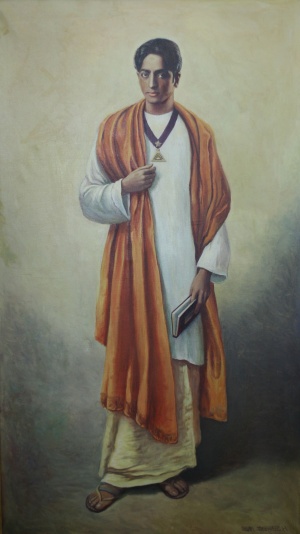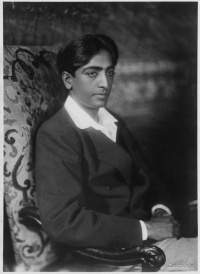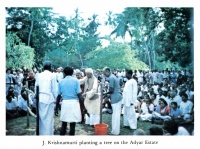Jiddu Krishnamurti: Difference between revisions
Pablo Sender (talk | contribs) |
Pablo Sender (talk | contribs) No edit summary |
||
| Line 3: | Line 3: | ||
<b>ARTICLE UNDER CONSTRUCTION</b><br> | <b>ARTICLE UNDER CONSTRUCTION</b><br> | ||
<b>ARTICLE UNDER CONSTRUCTION</b><br> | <b>ARTICLE UNDER CONSTRUCTION</b><br> | ||
[[File:Krishnamurti painting.jpg|300px|right|thumb|J. Krishnamurti portrait in L. W. Rogers Building. Painted from a photograph in 1926 by Henry Schwartz. Image from TSA Archives.]] | [[File:Krishnamurti painting.jpg|300px|right|thumb|J. Krishnamurti portrait in L. W. Rogers Building. Painted from a photograph in 1926 by Henry Schwartz. Image from TSA Archives.]] | ||
'''Jiddu Krishnamurti''' (1895 | '''Jiddu Krishnamurti''' ([[May 12]] 1895 – [[February 17]], 1986) was an author and lecturer on spiritual and philosophical subjects who had a major impact on Twentieth Century thought. He was "discovered" as a child in India by [[Charles Webster Leadbeater|Charles W. Leadbeater]], who believed that the boy had the potential to become a great religious leader. Krishnamurti and his brother Nitya were educated by Theosophists at the [[Theosophical Society (Adyar)|Theosophical Society]] based in Adyar, Chennai,India. Adyar Theosophists established the [[Order of the Star in the East]] to promote the idea the Krishnamurti was the much-anticipated "World Leader" or Maitreya. Eventually Krishnamurti rejected the role and the organization, and taught that "Truth is a pathless land". | ||
Krishnamurti was often referred to by his friends as "K". | Krishnamurti was often referred to by his friends as "K". | ||
== Early years and education == | == Early years and education == | ||
Jiddu Krishnamurti was born was born a Brahmin on [[May 11]] 1895 in Madanapalle, Andhra Pradesh, near Madras in the south of India. He was the eight son and, in keeping with tradition, was named after Sri Krishna. | |||
Although his father, Jiddu Narianiah, was educated at Madras University and worked for the British Administration, the standard of life of the family was not good. Only five or six of the eleven children of the family would survive childhood. When Krishnamurti was two years old he nearly died of malaria, and his mother, Jiddu Sanjeevamma, eventually died of it died when he was only ten. | |||
In 1907 his father was given a compulsory retirement. Having been a member of the Theosophical Society since 1882,<ref>Mary Lutyens, ''Krishnamurti: The Years of Awakening'' (New York: Farrar, Straus and Giroux, 1975), 6.</ref> he eventually obtained a job at the International Headquarters of the [[Theosophical Society (Adyar)|Theosophical Society]]. | |||
On [[January 23]], 1909, the Jiddu family moved to [[Adyar]], in Madras (now Channai). In May of that year, Theosophical leader and [[Clairvoyance|clairvoyant]] [[Charles Webster Leadbeater|C. W. Leadbeater]] runs into 13-year old Krishnamurti who was playing in the beach, and sees "the most wonderful [[aura]] he has ever seen, without a particle of selfishness". Although Theosophist and scholar [[Ernest Wood]], who had tried to help him with his homework, considered him dim-witted, Leadbeater predicted that he would become a spiritual teacher and a great orator "much greater" than even [[Annie Besant]].<ref>Mary Lutyens, ''Krishnamurti: The Years of Awakening'' (New York: Farrar, Straus and Giroux, 1975), 21.</ref> | |||
K was given mystical name 'Alcyone'. | |||
== World Teacher movement == | == World Teacher movement == | ||
Revision as of 19:47, 12 May 2014

ARTICLE UNDER CONSTRUCTION
ARTICLE UNDER CONSTRUCTION
Jiddu Krishnamurti (May 12 1895 – February 17, 1986) was an author and lecturer on spiritual and philosophical subjects who had a major impact on Twentieth Century thought. He was "discovered" as a child in India by Charles W. Leadbeater, who believed that the boy had the potential to become a great religious leader. Krishnamurti and his brother Nitya were educated by Theosophists at the Theosophical Society based in Adyar, Chennai,India. Adyar Theosophists established the Order of the Star in the East to promote the idea the Krishnamurti was the much-anticipated "World Leader" or Maitreya. Eventually Krishnamurti rejected the role and the organization, and taught that "Truth is a pathless land".
Krishnamurti was often referred to by his friends as "K".
Early years and education
Jiddu Krishnamurti was born was born a Brahmin on May 11 1895 in Madanapalle, Andhra Pradesh, near Madras in the south of India. He was the eight son and, in keeping with tradition, was named after Sri Krishna.
Although his father, Jiddu Narianiah, was educated at Madras University and worked for the British Administration, the standard of life of the family was not good. Only five or six of the eleven children of the family would survive childhood. When Krishnamurti was two years old he nearly died of malaria, and his mother, Jiddu Sanjeevamma, eventually died of it died when he was only ten.
In 1907 his father was given a compulsory retirement. Having been a member of the Theosophical Society since 1882,[1] he eventually obtained a job at the International Headquarters of the Theosophical Society.
On January 23, 1909, the Jiddu family moved to Adyar, in Madras (now Channai). In May of that year, Theosophical leader and clairvoyant C. W. Leadbeater runs into 13-year old Krishnamurti who was playing in the beach, and sees "the most wonderful aura he has ever seen, without a particle of selfishness". Although Theosophist and scholar Ernest Wood, who had tried to help him with his homework, considered him dim-witted, Leadbeater predicted that he would become a spiritual teacher and a great orator "much greater" than even Annie Besant.[2]
K was given mystical name 'Alcyone'.
World Teacher movement
Life-altering experiences
Death of his brother
Rejection of World Teacher role
Speaking tours
Krishnamurti schools
Later years
Teachings
Writings
Online resources
Audio
- Krishnamurti and Eastern Philosophy by Ravi Ravindra
- Krishnamurti on the Masters by Aryel Sanat


